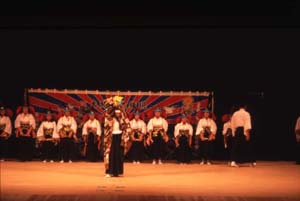
| Classification | Kagura |
|---|---|
| name | Natsuki Daisuke Tenkagura (Natsudai Bonten Kagura) |
| Designated date | May 7, 1999 |
| Holding group | Daisuke Natsui Tenkagura |
| location | Kuji City Natsui Town |
| home page | Iwate's Cultural Information Encyclopedia (Natsui Daisuke Tenkagura) |
Overview
According to the tradition of the Harima family, who inherited the Kagura, the ancestors are Yamabushi Osamu, who from Oyama's country (now Hyogo Prefecture) carry Otami Fudoakio on his back and emigrate to Natsui to build the Taihoin, and its Gongen It is said that the origin was the creation of Kagumi, the master of Kasumi. There is a line store in the house of the Harima family, which has a large floating Tenten impassive king, and there is a description of Bunko 3 (1354) in the tag, and also the study of Takara 4 (1754) and Bunsei 5 (1858) A diploma is also left. Kasumi-inspired Kagura tour has been suspended since 1957, due to the aging of the dancers, etc. In Kagura, a preservation society was formed in Showa 52 (1977) and the dancers rejuvenated. The successor training is also planned with a focus on junior high school students. Currently, he is dedicated to the annual festivals of Omiya Shrine (August 15), Wakamiya Hachimangu Shrine (old calendar August 15), Oyama Inari Shrine (May 5). In addition, we are invited to annual festival and new construction celebration of shrine in Kuji city, and there are more than 20 performances a year. It has been said that there were more than 50 programs before, but now there are 20 such as "Gongen Mai", "Riko Shibanban Mai", and "Toshio Mai". In particular, “Ishio Mai”, which dances while holding a tin can on the right hand and a fan on the left and holding rice with three treasures and divine sake, is one of the rare works in Yamabushi Kagura, and it is valuable.
Main performance place
Omiya Shrine Regular Festival (August)
